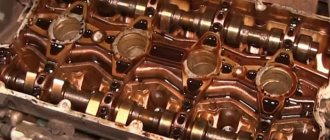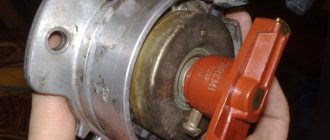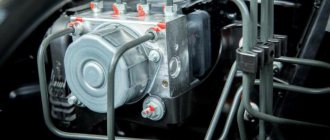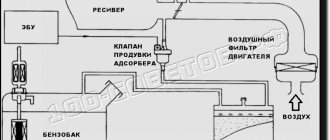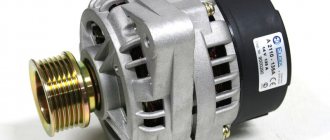Damper, what is this incomprehensible word in everyday life of car mechanics?
Undoubtedly, many have never heard of a car damper and have no idea what it is needed for. We will try to correct this defect and tell you about it in as much detail as possible. As the vehicle moves and interacts with various types of surfaces, vibration occurs between its individual parts. Of course, the design features of cars already provide some degree of protection against such phenomena. But sometimes they are not enough, which ultimately causes some discomfort.
It's quite easy to avoid this today. It is enough to install a special damper on the most susceptible systems or components. In essence, this is a small auxiliary shock absorber, with the help of which excess vibrations are “absorbed” and the stability of a particular system is stabilized, the level of vibration in it is reduced.
Physics of the process
An important property of the damper
is a decrease in the quality factor of the oscillatory system to which it is connected.
The principle of operation of the damper
is the irreversible conversion of the energy it receives into heat or destruction of the material. For example, oil in the shock absorber prevents its parasitic vibrations after the wheel passes an obstacle. The oil heats up.
Very good damper
is sand: when it absorbs energy, grains of sand rub against each other (
heating occurs
) and are crushed (
mechanical destruction
).
Types of dampers
Almost any product or device that is designed to soften something is called dampers. There are a great many of them. Likewise, the most common rubber gasket can be called a “damper”. What kind of device this is in a deeper sense will become clear after considering its main types. Dampers are pneumatic and hydraulic. However, there are many varieties of them. So, hydraulic ones are divided into:
- flow stabilizers;
- pulsation dampers;
- hydraulic shock mufflers;
- dampers.
Often membrane, piston or balloon accumulators are used as hydraulic devices of this type.
Motorcycle steering damper
In the modern world, there are motorcycles with various design features. Many motorcycle models are far from ideal. After all, manufacturers cannot foresee everything. During the operation of the motorcycle, the owners themselves determine what should be added to their bike so that riding it is comfortable and safe, and so that it lasts for many years.
The steering wheel plays an important role while driving. It is allowed to direct the movement of the vehicle along the way. However, in many motorcycle models, this part of the motorcycle equipment has its drawbacks, which consist in poor-quality fastening. For this reason, on the road the steering may fail and an accident may occur. Therefore, you should purchase dampers for your bike.
Application
Hydraulic and pneumatic dampers are used in hydraulic systems, automatic regulators and measuring instruments. Hydraulic dampers are divided into pulsation dampers, flow stabilizers, pulsation dampers and water hammer dampers. Also, to varying degrees, standard piston, balloon and diaphragm accumulators are used as hydraulic dampers.
In electrical machines, a damper (damper winding) is an inductor that prevents a sharp increase in switching currents or voltages in electrical circuits; for example, in the event of a short circuit or interference.
In stringed musical instruments, a damper is a device for stopping string vibrations, consisting of separate blocks (for a piano) or strips (for a harp), covered with soft felt (filt).
Suspensions of cars and other vehicles use damping devices called shock absorbers.
In acoustic systems (so-called “speakers”), a damper is a rim that secures the membrane of the sound element to the frame. Usually made from polymer materials (for high-frequency elements), rubber or foam rubber (for mid- and low-frequency elements). Used to dampen residual vibrations of the membrane.
In aviation: aeroelastic oscillation damper of an aircraft is an independent on-board electronic system or subsystem as part of an automatic flight control system (ACS), designed to automatically dampen short-period oscillations of an aircraft in flight, which inevitably arise when flight conditions change and, most importantly, to prevent involuntary rocking of the aircraft by the pilot, which can lead to significant overloads and structural failure. In technical terms, it consists of a group of gyroscopic sensors that control the angular movements of the aircraft in space, an electronic circuit for processing and amplifying damping signals and actuators connected in series to the mechanical control wiring, or these signals are mixed with other ACS control signals
The problem of longitudinal progressive swing was acutely manifested on the supersonic bomber Tu-22, for the same reason the experienced Su-27 was lost. The problem of lateral movement is still relevant for almost all heavy (including passenger) aircraft, and is referred to as the “Dutch step”. Almost all large passenger aircraft have automatic damping.
- In risk management, a damper
is a threshold value of safe risk for an enterprise. The risk damping mechanism involves analyzing possible threats or factors that give rise to these threats, determining security thresholds, and identifying the range of conscious risks that an economic entity is ready to take. - In programming, a damper
is a system for balancing the load on system components during surges in the data arrival rate.
Steering damper for motorcycle
Dampers for motorcycles are used in situations where:
- the driver knows for sure that he will squeeze maximum speed out of his motorcycle.
- the driver is confident that he will take part in sports motorcycle competitions.
- the driver sees that his steering is not working well.
In order for the damper to work properly and securely fix the steering, it must be installed correctly. This will make you feel comfortable and safe during the journey.
Installing the damper is an easy task. Any motorcyclist can handle it. For this purpose, detailed instructions are attached to each such product. It will allow you to securely fix the steering wheel so that it does not become loose while driving.
Functions of the damping element
The damper is universal. The structure is installed where shaking is especially noticeable, and the car’s own shock absorption system does not work at 100 percent.
Properties of the auxiliary element:
- absorption of steering vibrations;
- creating a balance between vibration amplitudes while driving along complex routes;
- increasing the degree of ride comfort;
- improving safety indicators.
Installing a damper solves problems that arise when traveling on problematic roads. This element is especially effective during braking or impact. If the device is installed on the steering mechanism, the vehicle's handling at medium or high speeds is noticeably improved.
Source
Additional dampers for the car
I
these shock absorbers are nothing more than a shock absorber, but only smaller in size than those used in suspension. By installing them on the engine and steering box, you can achieve a significant reduction in vibrations.
What is noteworthy is that many car owners, especially domestic ones, install shock absorbers on the steering of the Mercedes Benz itself and no major repairs are required.
As for engine shock absorbers, these devices are currently being produced for some models. These shocks come with all the instructions and hardware to install them. In addition, there are universal shock absorbers that can be installed on any car.
They come with a minimal set of fasteners. But how to install it on a car, the car owner himself will have to think about.
This way we will learn how shock absorbers are installed on a car. First, let's look at a vibration damping device for the engine.
Steering damper: why is it needed and how to install it. Cost and selection criteria
Not many people know what a steering damper is. Let’s say, many people don’t even need it! Apparently, therefore, this is not such a common and mandatory element in the steering of a car. In this article we will try to lift the curtain on what cars steering dampers are usually used for, what are the accepted rules for installing them and how much they generally cost.
Engine damper
its installation and engine damper
Installing it, in fact, is not very difficult. One end of the damper is attached to the car body, and the second to the engine. But how to secure it is already a question.
Based on this, we will first look at the damper fasteners, intended for installation only on Mazda 3 cars. The damper kit for this car includes the shock absorber itself, a mounting bracket installed on the engine, a mounting ring for the body, studs and bolts.
Installing this damper is not very difficult. All this
will be mounted in the engine compartment on the right side as you move.
The mounting ring has a special shape for installing it on the body at the location where the front pillar is attached. To install the ring, just unscrew the rack mounting bolts and place the ring so that the holes in it coincide with the rack mounting holes. After this, the bolts must be installed in place and tightened.
The mounting bracket is fixed to the engine, on the platform below the oil filler plug. To secure it, use the studs included in the kit.
After this, a damper is installed between the fasteners and secured with bolts. At this point, the installation of the damper on the Mazda 3 can be considered complete.
It is a couple of times more difficult to install this element. If it is universal and does not have special fastenings.
The damper can be installed relatively easily if the car has a suspension strut running under the hood. It is precisely to this that it is possible to attach one damper finish.
A mounting bracket will probably need to be made to mount it to the engine. The main thing is to choose the right mounting location. It is possible to press the manufactured bracket with some engine bolts.
In general, this is a matter of choice for the car owner himself.
If there is no spacer, some people make their own mounting ring to the car body. In general, the fastening method is not very important, the main thing is that one end of the damper is attached to the body, and the second to the engine.
Advantages and disadvantages of auto dampers
If you have not yet decided whether you need such a device or can do without it, you should familiarize yourself with their advantages and disadvantages.
Let's start with the pros:
- significant shock mitigation. The wheel axle is the first to take on the load when hitting road irregularities, but standard shock absorbers do not cope with their task completely and not always. A modern damper reduces the vibration force by about 30%, both in relation to the steering wheel and in relation to the engine. Obstacles such as tram tracks, slab joints, wide cracks in the road surface, and even speed bumps will be overcome much more smoothly;
- Suspension knocks are always an unpleasant sound. Steering/engine dampers allow you to get rid of it, if not completely, then significantly;
- Vibration of a car during heavy braking is also not a pleasant phenomenon, as is the case when accelerating above 100 km/h. It is also worth mentioning a similar phenomenon with deformed disks, in the absence of proper wheel balancing. Additional shock absorbers will eliminate this problem;
- A steering damping device can improve vehicle handling when driving at above-average speeds.
But this node cannot be called ideal either, and here’s why:
- When installing a damper on the steering wheel, at first you will have to get used to the “wobbiness” of the steering wheel, and it is far from a fact that you will come to terms with it;
- the same can be said about the effort applied when rotating the steering wheel.
However, according to a statistical survey, over 80% of drivers who have installed additional shock-absorbing units on their cars are satisfied with their performance.
At the same time, there is a risk that you will fall into the opposite camp - every fifth car owner either did not feel the difference before and after installing the damper, or was dissatisfied with its performance.
Dampers from Dayco. What is a damper and why is it needed?
Dayco, a leading supplier of engine and drive system products to the automotive and aftermarket markets, is also a major player in the manufacture of original equipment vibration dampers (or vibration dampers), which are manufactured for many well-known vehicle manufacturers, both for automobiles and and equipment for use in harsh conditions, throughout Europe and around the world.
Dayco, a leading supplier of engine and drive system products to the automotive and aftermarket markets, is also a major player in the manufacture of original equipment vibration dampers (or vibration dampers), which are manufactured for many well-known vehicle manufacturers, both for automobiles and and equipment for use in harsh conditions, throughout Europe and around the world.
Damper: excess or necessity
It is quite possible that a considerable part of our readers do not even know the meaning of this word. Indeed, this term is extremely rare in everyday life, except in places such as service stations or car services.
But the word shock absorber is familiar to all car owners. Of course, it is associated exclusively with the chassis of the car. Meanwhile, shaking and vibration are harmful not only to parts and components of the chassis. Considering the quality of Russian roads, one can imagine the loads the power unit is subjected to. And although it has standard protection against such troubles, in some cases it is clearly not enough.
The same can be said about the steering wheel - an organ that for the driver is the very place through which he is constantly in contact with his car. And such contact does not always bring satisfaction - if the steering wheel shakes, it causes quite noticeable discomfort to the driver.
Special dampers help avoid such situations. Essentially, these are miniature shock absorbers that allow damping (smoothing) vertical and other types of vibrations and vibrations.
Common Applications
You can see a damper in action quite often; you just need to pay attention to the little things that will tell you that this is exactly the device.
Dampers of various types can become an indispensable component for measuring instruments and automatic regulators. With its help, you can significantly reduce the risk of current fluctuations, protect equipment from sudden increases in voltage, and much more.
The automotive industry has long been introducing dampers into various parts of the structure; without shock absorbers, the vehicle’s suspension will not last long, and the ride itself will seem unbearably stressful to both the driver and passengers.
What is a damper, its functions
There are many similar devices, but most often they use dampers that protect the power unit and steering controls from unnecessary loads.
However, many sports and racing cars have such shock-absorbing devices installed as standard. Ordinary passenger cars are not equipped with such dampers, so they must be purchased separately and installed independently or with the help of car service specialists.
Structurally, and to some extent technologically, the damper is a universal device that allows installation on any type of vehicle. The main task is to ensure reliable fastening, and here you will need to show a lot of ingenuity. In some cases, they even resort to welding, thus attaching the fasteners required to fix the damper to the bottom or body elements.
In car dealerships, such shock-absorbing equipment is usually sold together with a minimum set of fasteners, thanks to which the choice of installation method is greatly simplified.
In what cases will a damper be a really useful and even necessary purchase? If in your daily travel area the road is ideal or close to it, the need for this part will be minimal or close to zero. In the absence of excessive loads on the car, a standard shock absorber will cope perfectly with small and rare potholes and humps. But if, due to circumstances, you are forced to often drive off-road or on paved roads that are in terrible condition, the shock-absorbing system will not be able to cope with the damping of vibrations that constantly occur with different frequencies and amplitudes. This is where an additional damper comes in handy, the effect of which will be combined with the work of the suspension.
Car dampers are devices specially designed to absorb vibrations that shock absorbers cannot cope with. Be it the steering or the engine housing along with all attachments.
Since not a single, even the most expensive and high-quality shock absorber is able to completely eliminate vertical and other vibrations, the main task facing the damper is to suppress the amplitude of such vibrations as much as possible. A high-quality device copes well with this problem, while having compact dimensions. The car owner’s task is to install it correctly. It is highly desirable that they be invisible, or even better, invisible.
Dampers are equipped with one-way (in such cases it is usually supplied with a spring) and two-way shock absorbers. Externally, such a device is very similar to a classic shock-absorbing strut, typical for the suspension of any vehicle. The principle of operation of the damper is also similar to modern shock absorbers.
You can also find budget versions on sale, in which the role of a damping element is played by a liquid (most often oil) placed in a special tank with a partition.
The design of the damper provides for the presence of valves or relief holes, through which the driver can adjust the degree of vibration smoothing.
All modern dampers are structurally divided into two categories:
- telescopic devices that are mounted along the protected part (for example, on a steering column). This is precisely the principle used in standard shock absorbers. The composition of the damper is also similar: it is a cylinder with a piston inside;
- rotary damping devices, which work on the same principle, but are structurally designed in a completely different way. Such devices are considered more reliable, characterized by increased strength. They are able to withstand not only vibrations and vibrations, but also impacts of decent force. It is no coincidence that they are usually installed in bikes and sports cars.
Why do you need a steering damper?
The purpose of a steering damper is to dampen the shaking of the steering column while driving on an uneven road surface. The damper is able to effectively absorb such vibrations, shocks and vibrations. At the same time, the looser the steering wheel is, the more pronounced the resulting vibration will be. The steering vibration damper copes well with this problem and makes off-road driving comfortable. In addition, the damper also serves to return the steering wheel to the zero position. It helps maintain a straight path for traffic. Structurally, it is no different from an engine damper and is a smaller version of a conventional shock absorber. If the device has a one-way action, it is equipped with a spring. Visually, a damper of this type resembles a shock-absorbing strut, the dimensions of which are much smaller.
More details about the car damper will be discussed in this video:
Published: June 03, 2020
Where is a damper used?
The most common use of dampers can be seen in the process of strengthening the protection of engines and steering systems.
It is in these places that the presence of additional vibration causes an increased level of discomfort. You need to understand that on modern sports or high-speed cars, the presence of dampers is provided structurally. But this does not mean that this device cannot be installed on a vehicle of another model.
It is important to understand here that the damper is technologically compatible with almost all types of cars. True, you will have to tinker a little with the fastenings, up to a small constructive intervention, in the form of welding special fastening brackets to the bottom or body, to which the damper will be attached
It should be noted that dampers are supplied with a minimum required set of fastening elements, which greatly simplifies the search for the necessary parts for their installation and fastening.
Now a little about when you should use a damper on cars. Of course, if the road is smooth, there are no potholes, and there are no various excess loads on the car. The role of the damper will be reduced to a minimum during car operation, so its use may not even be advisable. But if you are constantly driving on uneven terrain, where the car is subjected to tests of stability and structural strength, the occurrence of excessive vibrations is common.
It is in this case that the damper will be the ideal solution to reduce (and in some cases become the basis for its complete absence) the impact of vibration on the car body and on the steering. As a result, the driver, holding the steering wheel, will not feel hesitation, and during turns, the feeling that the steering wheel is not listening to you, or the wheels are turning in the other direction, will also not appear.
Damper devices are ideal for SUVs of various types and models, as well as vehicles that most of the time travel on country roads or roads with damaged surfaces.
Motor damper: what is it?
At the moment of gear shifting, maximum vibration amplitudes occur in the engine. This is especially noticeable in high-revving engines, which are mainly used in luxury and sports cars. Thus, an engine shock absorber is a miniature version of a conventional shock absorber and acts as a vibration damper. This is due to the fact that the upper rod begins to move towards the chamber with oil under pressure. This happens quickly at first and slows down over time. Shock absorbers are usually attached to the studs of body parts in the support bearing mounting area. The upper end of the device is attached to the block in the pillow area.
General information
Translated from German, the word “damper” means “to dampen, muffler.” By and large, this device is a kind of shock absorber, which is designed to prevent vibrations that occur in various systems, devices, machines, structures and structures during their operation. How to define the concept of “damper” in a general sense? What this is is quite simple to understand, since all devices that act soothingly and softly can be called this term.
How to install?
Now that we know what device we are talking about, it’s time to figure out its implementation in the automotive system. You can install the damper on the steering rod with the help of specialists or yourself. Since the first method does not need a detailed description, let’s look at how to attach the damper with your own hands.
Most often, the steering damper is installed in the space between the moving rods. But often this device is mounted between the rod and the body. However, with this option you need to be careful. If the mechanism is fixed in a place where the body stroke reaches its maximum level relative to traction, the damper, due to the rigidity of its design, will slightly steer the car on bumps. This is an unacceptable defect.
When installing, make sure that the presence of the damper does not change the amplitude of rotation of the axes. It must remain the same, otherwise it will reduce the ability to control the vehicle.
Fastening
So, now you are ready to equip your car with a damper. Let's get to work. First you need to take a corner that should be welded to the place where you decide to mount the device. There should be a hole on the corner for fastening.
We weld the same fastener to the rod. Let us remind you that you need to carefully select the welding location. The rod should continue to move freely after installing the damper.
Installation
After this we can install the damper. Each end is inserted into a mounting hole and secured there.
If you purchased a universal device, you will not have to weld anything additional. It is enough to attach the clamps.
We remind you that the device must be mounted as perpendicular to the draft as possible.
Steering damper
Installing the steering damper
Such devices can also be sold as a kit with all fasteners. But some people simply purchase a damper from Mercedes Benz and install it on their car.
This is located along the steering mechanism. As in the case of the engine damper, one end of it is attached to the body, and the other is attached directly to the mechanism at the point where the rods are attached to the rack.
Some versions come complete with a special spacer, making the structure more rigid and reliable.
Let's look at how to install a damper from Mercedes Benz. So, there is only a damper, but you need to provide mounting points for it.
To do this, you need to unscrew the steering gear mounting bracket, the one closest to the expansion tank. Next, a plate with a hole for attaching the damper is welded to this bracket.
Something else useful for you:
- Reasons why the shock absorber knocks
- MacPherson suspension - design, principle of operation, advantages and disadvantages
- How to choose the right shock absorber for a car
Video: Installing a Damper on a UAZ Patriot
https://youtube.com/watch?v=yGliSjVdfqg
Then you will need an adapter to attach the damper to the mechanism rack. To do this, a plate shaped like a heart is cut out of metal.
Three holes need to be drilled in this plate. Two should coincide with the holes for attaching the rods to the rail. Below these two holes there should be another one - for attaching the damper.
After this, you can begin assembly. First, the mechanism fastening bracket is installed, and the end of the damper is already attached to it.
Then you need to unscrew the bolts securing the rods, press the prepared adapter to the rods and screw the bolts back. Then the other end of the damper is screwed to the adapter.
If you purchase a kit that includes a special spacer, then installing everything will not be difficult at all.
In this kit, in addition to the damper itself and the spacer, there are also brackets for fastening the mechanism, but modified to install a spacer and a vibration damping element. Usually the kit also includes an adapter.
All that remains for installation on the steering mechanism is to remove the factory mounting brackets and install them in place that come with the kit.
Then the spacer is installed and secured. All that remains is to secure the adapter and install the damper.
All this work is not so complicated, but the benefits of using dampers are significant. Car owners who have installed an engine damper note a decrease in vibration of the power plant, and gear shifting becomes “clearer”.
As for the steering dampers, it is noted that impacts from the wheels on the steering wheel are softened, vibration of the steering wheel during braking is reduced, and knocks from the suspension are reduced.
Furniture industry
Any modern design is equipped with a damper, because with such a component things can become much more practical and convenient.
The device is specially designed for each furniture model, the size and load are adjusted. Doors in rooms can open smoothly, the knock from closing is smoothed out as much as possible thanks to such a modern device.
It is no longer possible to imagine flaps without furnished samples, because they not only prevent noise, but can also make use comfortable. All parts are made from high-quality materials, the service life is quite long if the item was produced taking into account technological requirements.
What is Dual Mass Clutch?
The dual-mass flywheel consists of two housings. The first is the same classic flywheel with a toothed ring mounted on the crankshaft. The second housing, supported by a sliding bearing, is connected to the clutch mechanism if the transmission has a manual gearbox, or to the torque converter if the car is equipped with an automatic transmission.
Interesting materials:
What to do if the start menu does not open? What to do if Nvidia does not open? What to do if the Nvidia panel does not open? What to do if the call is not displayed? What to do if emoticons are not displayed on Instagram? What to do if notifications do not arrive in Telegram? What to do if the letter does not arrive in the mail? What to do if the play market does not download? What to do if you can’t hear in ZOOM? What to do if you did not have time to submit an application for Usn?


